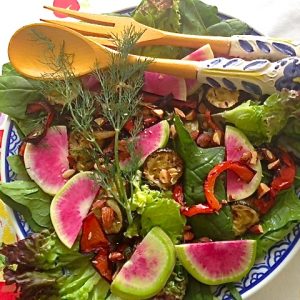A version of this post originally ran on November 10, 2014. For Huffington Post’s Meatless Monday
In his 2008 book, In Defense of Food, Michael Pollan gave us the prescription in seven words — “Eat food. Not too much. Mostly plants.” It’s that simple. And that hard to do. I saw just how hard when I recently participated in the James Beard Foundation food conference.
Over two dynamic days, food experts and advocates including White House chef and U.S. Nutrition Policy advisor Sam Kass, Mark Bittman, National Family Farm Coalition head Ben Burkett, Laurie David of “Fed Up” fame and Pollan himself gathered to discuss “Health and Food: Is Better Food the Prescription for a Healthier America?” Well, that’s obvious — yes. The details are where things get complicated.
The problem is financial and social inequity. The problem is the how little nutrition information doctors have — it’s not taught in medical school. The problem is the food industry. The problem is us and our human resistance to change. Turns out what needs to happen to fill Pollan’s simple prescription is as multi-faceted as a diamond and about as hard to cut into. We wound up with more obstacles than answers.
Missing from the conversation — the mostly plants part, the positive health and environmental impacts of lowering meat consumption. No one said a meatless diet is bad for you, because of course no one can. The nonprofit Wholesome Wave has even created a Fruit and Vegetable Prescription program. But the conference’s headliners who could have raised the myriad benefits of a meatless diet never did (and you know who you are). I brought it up. It went nowhere. The only speaker to mention it is Dr. Derek Yach of the Vitality Institute, a global health and food policy pro who’s learned some battles are easier to win than others.
The conference showed there’s a greater interest and awareness in what we eat and how we eat. That’s great. But it’s not the same as change. Pollan’s prescription’s still sound. But now he admits, “It’s hard to get people to change.”
If we agreed on one thing, it’s this — what needs to change is everything. “The world’s a messy place,” says Kass. “Do everything you can at every turn.”
Start in the kitchen. Cooking, whether you learn it in school or at home empowers you. It means you aren’t beholden to food companies and don’t buy into their lies that cooking is drudgery, that it’s a time suck and expensive and we’re incapable. Cooking isn’t any of those things. It’s a basic life skill. So’s eating. We could do better there, too. Each week, try eating one more meatless meal. Try making one more home-cooked meal. Small, but doable actions make Michael Pollan’s prescription easy to fill.
Hero Food author and Tertula chef Seamus Mullen agrees.”The first step is getting people around the table and actually cooking with real ingredients that you can pronounce and recognize.” Mostly plants.
Plant Prescription Salad with Mustard and Dill
By Michael Pollan. Here's an autumn salad with bright flavors and colors. It's pretty enough for your holiday table, easy enough not to freak you out in the kitchen.Ingredients
- 1/4 cup olive oil
- 2 teaspoons Dijon mustard
- 2 teaspoons sherry or cider vinegar
- 1 tablespoon agave or honey
- 2 tablespoons fresh dill finely chopped, plus additional for garnish, if desired
- 1 zucchini sliced into thin discs
- 1 medium onion sliced into half moons
- 1 red pepper sliced into slim strips
- 4 to 5 cups loosely packed tender greens -- arugula lettuce, whatever's at your farmers market
- 1/2 bunch French breakfast radish watermelon radish or other mild radish, sliced thin (about 1 cup)
- 1/4 cup toasted almonds coarsely chopped
Instructions


Leave a Reply